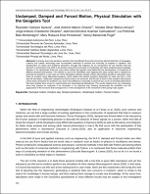| dc.contributor.author | Campos Saravia, Reynaldo | |
| dc.contributor.author | Manco Chávez, José Antonio | |
| dc.contributor.author | Manco Arroyo, Nicolas Silver | |
| dc.contributor.author | Crisóstomo Olivares, Jorge Antonio | |
| dc.contributor.author | Huaman Carhuatocto, Jeannina Del Alva | |
| dc.contributor.author | Blas Montenegro, Luz Petronila | |
| dc.contributor.author | Díaz Hinostroza, Mary Rosaura | |
| dc.contributor.author | Barazorda Puga, Nancy | |
| dc.date.accessioned | 2023-12-20T18:46:25Z | |
| dc.date.available | 2023-12-20T18:46:25Z | |
| dc.date.issued | 2023 | |
| dc.identifier.uri | https://hdl.handle.net/20.500.13067/2879 | |
| dc.description.abstract | Currently due to the pandemic situation that has affected the world community without distinction of languages, customs and creeds, technology was incorporated massively to achieve the continuity of progress in research, and development of culture and academic education, through this progress. As an introduction we can mention that this research is achieved by the need to do physics using other tools easy to manipulate with basic programming knowledge, likewise in the repositories there are many other studies that applied computationally the development of simulations of different physical phenomena. The method to use is the GeoGebra tools applying the basic syntax that is obtained by entering the equations in the input bar of the GeoGebra software already preset, being these equations calculated many times by students using differential equations, which obtains the solution equation dependent on mass and time, in this way the simulation, undamped, damped and forced motion are achieved, with the aim to show in this research that physics can be done using tools for academic use, due to this software is not exactly a research tool, but it can simulate phenomena that have already been shown in experimental and computational laboratories. The results obtained are very interesting since they present an originality in its simulation in an objective way showing dynamically the oscillation and the appearance of the functions that correspond to it in the development of the movement of the spring mass system. | es_PE |
| dc.format | application/pdf | es_PE |
| dc.language.iso | eng | es_PE |
| dc.publisher | International Journal of Membrane Science and Technology | es_PE |
| dc.rights | info:eu-repo/semantics/openAccess | es_PE |
| dc.rights.uri | https://creativecommons.org/licenses/by/4.0/ | es_PE |
| dc.subject | Damped motion | es_PE |
| dc.subject | Hooke’s law | es_PE |
| dc.subject | Simple pendulum | es_PE |
| dc.subject | Undamped motion | es_PE |
| dc.subject | Forced motion | es_PE |
| dc.title | Undamped, Damped and Forced Motion, Physical Simulation with the Geogebra Tool | es_PE |
| dc.type | info:eu-repo/semantics/article | es_PE |
| dc.identifier.journal | International Journal of Membrane Science and Technology | es_PE |
| dc.identifier.doi | https://doi.org/10.15379/ijmst.v10i2.1258 | |
| dc.subject.ocde | https://purl.org/pe-repo/ocde/ford#2.02.04 | es_PE |
| dc.source.volume | 10 | es_PE |
| dc.source.issue | 2 | es_PE |
| dc.source.beginpage | 453 | es_PE |
| dc.source.endpage | 470 | es_PE |


